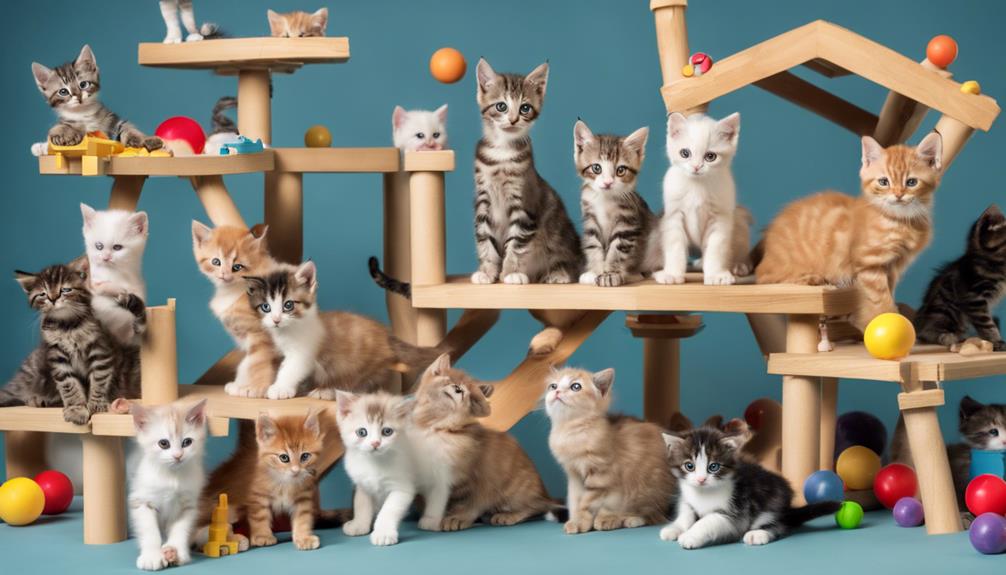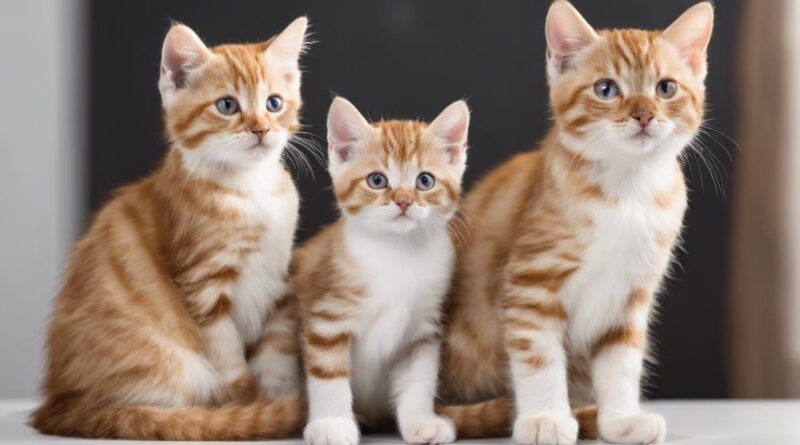Why Follow Certain Steps for Breeding Pedigree Cats?
When it comes to breeding pedigree cats, remember the old saying, 'You reap what you sow.' Ensuring a healthy lineage requires meticulous attention to detail. From selecting the right breeding pairs to understanding the intricacies of genetics, each step plays a crucial role in the process.
But why go through all this trouble? Well, the answer lies in the ultimate goal of producing top-quality, healthy kittens. So, let's delve into the significance of following these specific steps for breeding pedigree cats.
Importance of Selecting Healthy Cats
When breeding pedigree cats, selecting healthy felines is crucial for ensuring the well-being of future generations. Genetic testing plays a vital role in this process, allowing breeders to identify potential hereditary health issues that could be passed down to offspring. By conducting genetic testing on breeding cats, you can make informed decisions to prevent the transmission of harmful genetic conditions, ultimately improving the overall health of the breed.
In addition to genetic testing, breeding ethics must always be at the forefront of your practices. It's essential to prioritize the health and welfare of the cats above all else. This means not only selecting cats with good physical health but also considering their mental well-being. Ensuring that the breeding cats are happy and well-cared for contributes to the production of healthy kittens with strong immune systems and resilient temperaments.
Understanding Genetics in Breeding
To successfully navigate breeding pedigree cats, understanding the principles of genetics is essential. Genetic diversity and inheritance patterns play crucial roles in determining the characteristics of the offspring.
Here are three key points to consider:
- Genetic Diversity: When breeding pedigree cats, it's important to maintain genetic diversity within the breed. Limited genetic variation can lead to health issues and reduced fertility. By understanding the genetic makeup of the cats you're breeding, you can make informed decisions to preserve diversity and ensure the overall health of the breed.
- Inheritance Patterns: Traits in cats are inherited following specific patterns. For example, some traits may be dominant, meaning they're more likely to be expressed in the offspring, while others may be recessive and require both parents to carry the gene for the trait to be visible. Understanding these inheritance patterns is crucial for predicting the outcomes of breeding and selecting for desired traits.
- Selective Breeding: Through selective breeding, breeders aim to perpetuate desirable traits and characteristics in pedigree cats. By carefully choosing which cats to breed based on their genetic makeup and desired traits, breeders can work towards improving the overall quality of the breed while maintaining genetic diversity.
Proper Nutrition for Breeding Cats
Maintaining optimal nutrition is crucial for breeding cats to ensure their health and reproductive success. Meeting the dietary requirements of breeding cats is essential to support their energy levels and overall well-being. High-quality cat food formulated for breeding cats is recommended to provide the necessary nutrients such as protein, vitamins, and minerals.
When it comes to dietary requirements, breeding cats need a diet that's rich in protein to support their increased metabolic needs during reproduction. Look for cat foods that list a high-quality protein source, such as chicken or fish, as the main ingredient. Additionally, ensure that the food provides a balanced mix of carbohydrates and fats to meet the cat's energy requirements.
In some cases, it may be beneficial to incorporate nutritional supplements into the breeding cat's diet. Consult with a veterinarian to determine if supplements such as omega-3 fatty acids or prenatal vitamins are necessary to support the cat's reproductive health. These supplements can help fill any nutritional gaps in the cat's diet and promote optimal breeding conditions.
Ensuring Suitable Breeding Environment
Creating a suitable breeding environment is essential for the health and well-being of your pedigree cats. To ensure the best conditions for your breeding program, consider the following:
- Breeding Ethics and Environmental Impact: It's crucial to uphold high breeding ethics and standards to maintain the well-being of your cats and minimize the environmental impact of your breeding practices. Providing a clean and safe environment with adequate space for each cat promotes their physical and mental health, contributing to a positive breeding experience.
- Genetic Diversity for Long-Term Health: Introducing genetic diversity into your breeding program is vital for the long-term health and sustainability of your pedigree cats. Avoiding inbreeding helps prevent the propagation of genetic disorders and increases the overall resilience of the breed. By carefully planning matings and considering genetic variations, you can improve the health and vitality of future generations.
- Optimal Living Conditions: Creating an optimal living environment involves more than just basic needs. Providing enrichment activities, such as climbing structures, toys, and scratching posts, can help prevent boredom and promote natural behaviors. Additionally, ensuring proper ventilation, temperature control, and access to clean water and food are essential aspects of maintaining a suitable breeding environment for your pedigree cats.
Regular Veterinary Check-ups
Regular veterinary check-ups are essential for ensuring the health and well-being of your pedigree cats. These check-ups play a crucial role in monitoring your cats' overall health, addressing any potential issues early on, and ensuring they're in optimal condition for breeding. During these check-ups, the veterinarian won't only examine your cat's physical health but also provide guidance on grooming requirements and reproductive health.
When it comes to grooming requirements, regular veterinary check-ups offer an excellent opportunity to discuss the specific needs of your pedigree cats. Depending on the breed, some cats may require more frequent grooming to prevent matting and skin issues. The veterinarian can provide valuable insights into the proper grooming techniques, products to use, and any signs of skin or coat problems to watch out for.
In terms of reproductive health, veterinary check-ups are essential for breeding pedigree cats responsibly. The veterinarian can conduct tests to ensure your cats are healthy and ready for breeding. They can also provide advice on the best timing for mating, potential fertility issues, and prenatal care for pregnant cats. By staying on top of your cats' reproductive health through regular veterinary check-ups, you can increase the chances of successful breeding outcomes and maintain the well-being of your pedigree feline companions.
Responsible Breeding Practices
Adhering to ethical breeding practices is crucial for ensuring the health and well-being of your pedigree cats. Responsible breeding not only contributes to maintaining the standards of the breed but also minimizes the risk of genetic health issues.
Here are three essential practices to follow when engaging in ethical breeding:
- Prioritize Genetic Diversity: It's vital to maintain genetic diversity within the breed to prevent the emergence of inherited diseases. By carefully selecting breeding pairs that complement each other genetically, you can help ensure healthier offspring with a broader genetic pool.
- Health Screening: Before breeding your cats, it's imperative to conduct thorough health screenings to identify any potential genetic disorders that could be passed down to the kittens. This proactive approach can help prevent the spread of hereditary diseases and promote the overall well-being of the breed.
- Responsible Placement of Kittens: Ethical breeding extends beyond the act of mating cats. It also involves finding suitable homes for the kittens. Ensure that potential owners are informed about the breed's characteristics, needs, and any health considerations. Responsible placement helps guarantee the long-term welfare of the kittens.
Socialization of Kittens

To ensure well-adjusted and sociable pedigree cats, focus on actively engaging and familiarizing kittens with various stimuli during their early developmental stages. Early handling and socialization are crucial in shaping a kitten's behavior and temperament. From the moment they're born, kittens should be gently handled to get them accustomed to human touch. This early interaction helps them build trust and confidence around people, leading to more affectionate and friendly adult cats.
Bonding with your kittens through playtime is another essential aspect of their socialization. Engaging in interactive play sessions not only provides physical exercise but also strengthens the bond between you and the kittens. Use toys that encourage natural behaviors like hunting and chasing to keep them mentally stimulated and socially active. These activities help kittens develop important social skills, such as communication and appropriate play behavior.
Introducing kittens to different environments and experiences during their socialization period is also beneficial. Exposing them to various sounds, textures, and situations in a controlled manner can prevent them from becoming fearful or anxious around new stimuli later in life. By following these socialization practices, you can raise well-adjusted pedigree cats that are confident, friendly, and comfortable in various social settings.
Finding Suitable Homes for Kittens
When placing your kittens in new homes, prioritize finding suitable environments that cater to their unique needs and ensure their well-being. Here are three essential steps to consider during the adoption process:
- Screening Applicants: It's crucial to thoroughly vet potential adopters to guarantee that they can provide a loving and responsible home for your kittens. Ask questions about their experience with cats, living situation, and willingness to commit to the long-term care of the feline companion.
- Follow-Up Visits: After the initial adoption, schedule follow-up visits to ensure that the kittens are adjusting well to their new environment. This allows you to address any concerns, provide guidance on proper care, and offer support to both the kittens and the new owners.
- Support Network: Establish a support network for new owners, offering resources, guidance, and assistance whenever needed. This network can include fellow breeders, veterinarians, or online communities where adopters can connect with others who've experience in raising pedigree cats.
Frequently Asked Questions
Can Pedigree Cats Be Bred With Non-Pedigree Cats?
Yes, you can breed pedigree cats with non-pedigree cats. When crossing these felines, their genetics mix, influencing the traits of the offspring. This can result in a blend of characteristics from both parent breeds.
However, it's crucial to consider the implications of crossbreeding on the purity and standards of the pedigree line. Be mindful of the desired traits and qualities you aim to preserve in the breeding process.
How Do You Determine the Best Time for Breeding a Female Cat?
To determine the best time for breeding a female cat, monitor her hormonal changes. Pay attention to signs of ovulation like increased vocalization and affection.
Note the breeding season and fertility markers such as vaginal discharge and behavior changes. Consult with a veterinarian to pinpoint the optimal window for successful mating.
Timing is crucial for a successful breeding process and ensuring the health of the female cat and her offspring.
Are There Any Common Genetic Disorders That Pedigree Cats Are Prone To?
When breeding pedigree cats, it's crucial to be aware of common genetic disorders they might be prone to. Through genetic testing and adhering to breeding standards, you can minimize the risk of passing on these health implications.
What Is the Average Lifespan of a Pedigree Cat Compared to a Non-Pedigree Cat?
When it comes to the average lifespan of a pedigree cat compared to a non-pedigree cat, there are differences to consider.
Pedigree cats often benefit from better health due to controlled breeding practices, which can lead to increased longevity.
How Do You Handle Complications During the Breeding Process?
When handling complications during the breeding process, it's crucial to stay vigilant and prepared for any breeding challenges that may arise.
Monitoring the health of the cats involved, seeking advice from a vet, and being ready to intervene if necessary are key steps in managing potential issues.
Conclusion
In conclusion, following specific steps for breeding pedigree cats is crucial for ensuring the health and well-being of the cats and their offspring.
By selecting healthy cats, understanding genetics, providing proper nutrition and a suitable environment, regular vet check-ups, practicing responsible breeding, socializing kittens, and finding suitable homes, you can contribute to the overall success and happiness of the breeding process.
Remember, responsible breeding practices lead to healthy and happy cats.
